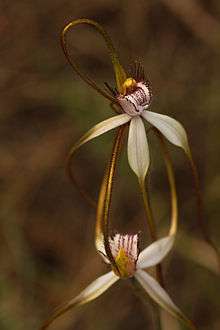Caladenia longicauda subsp. borealis
| Daddy-long-legs spider orchid | |
|---|---|
 | |
| Caladenia longicauda subsp. borealis near Eneabba | |
| Scientific classification | |
| Kingdom: | Plantae |
| (unranked): | Angiosperms |
| (unranked): | Monocots |
| Order: | Asparagales |
| Family: | Orchidaceae |
| Subfamily: | Orchidoideae |
| Genus: | Caladenia |
| Species: | C. longicauda |
| Subspecies: | C. l. subsp. borealis |
| Trinomial name | |
| Caladenia longicauda subsp. borealis Hopper & A.P.Br. | |
| Synonyms[1] | |
| |
Caladenia longicauda subspecies borealis, commonly known as daddy-long-legs spider orchid is a species of orchid endemic to the south-west of Western Australia.
Description
Caladenia longicauda is a terrestrial, perennial, deciduous, herb with an underground tuber and a single hairy leaf 6–12 mm (0.2–0.5 in) wide. It is usually solitary but sometimes grows in small clumps, flowering between July and September. There are usually between one and three flowers on a stalk 250–400 mm (10–20 in) tall, each flower 90–120 mm (4–5 in) wide. The flowers are mostly white except for a few red markings and reddish stripes on the backs of the petals and sepals. The dorsal sepal is green, erect, 60–100 mm (2–4 in) long and 2–3 mm (0.08–0.1 in) wide with its edges slightly turned inwards. The lateral sepals are 70–100 mm (3–4 in) long, 4–7 mm (0.2–0.3 in) wide, spreading horizontally and stiffly near their bases but then drooping. The petals are 60–95 mm (2–4 in) long, 3–4 mm (0.1–0.2 in) and droop like the sepals. The labellum is white, 15–20 mm (0.6–0.8 in) long, 7–10 mm (0.3–0.4 in) wide with erect to spreading teeth up to 10 mm (0.4 in) long along its sides. The middle part of the labellum has the longest teeth on its edge, the teeth red with hooked white tips. The front part of the labellum curves downwards, with the teeth becoming shorter. There are between four and eight rows of calli along the central part of the labellum, the calli pale to dark red and club-shaped, up to 1.5 mm (0.06 in) tall. The fruit is a non-fleshy, dehiscent capsule containing a large number of seeds.[2][3][4]
Taxonomy and naming
In 2001, Stephen Hopper and Andrew Brown published a review of the genus Caladenia in the journal Nuytsia and described eleven subspecies of Caladenia longicauda including subspecies borealis. (Three new subspecies have since been added.)[1][5] The name borealis is derived from the Latin word boreas meaning "northerly".[6]
Distribution and habitat
Daddy-long-legs spider orchid is relatively widespread and locally common, usually growing in sandy, well-drained soil in Wandoo woodland, near creeks, in sheoak groves and Acacia thickets between Cataby and the Murchison River[2][3][4] in the Avon Wheatbelt, Geraldton Sandplains, Jarrah Forest and Swan Coastal Plain biogeographic regions.[7]
Conservation
Caladenia longicauda subsp. borealis is classified as "Not Threatened" by the Western Australian Government Department of Parks and Wildlife.[7]
References
- 1 2 "Caladenia longicauda borealis". APNI. Retrieved 31 July 2016.
- 1 2 Brown, Andrew P.; Brockman, Garry (2015). "New taxa of Caladenia (Orchidaceae) from south-west Western Australia". Nuytsia. 25: 45–123.
- 1 2 Jones, David L. (2006). A complete guide to native orchids of Australia including the island territories. Frenchs Forest, N.S.W.: New Holland. pp. 61–62. ISBN 1877069124.
- 1 2 Hoffman, Noel; Brown, Andrew (2011). Orchids of South-West Australia. (3rd ed.). Gooseberry Hill: Noel Hoffman. p. 94. ISBN 9780646562322.
- ↑ Hopper, Stephen; Brown, Andrew (2001). "New taxa and circumscriptions in Caladenia". Journal. 14 (1/2): 111–112.
- ↑ Brown, Roland Wilbur (1956). The Composition of Scientific Words. Washington, D.C.: Smithsonian Institution Press. p. 158.
- 1 2 "Caladenia longicauda borealis". FloraBase. Western Australian Government Department of Parks and Wildlife.